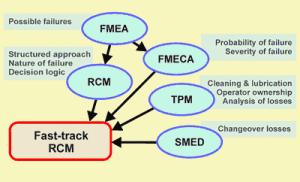A Proven Framework to Improve Performance and Build Ownership of the Equipment
Understanding the how equipment failures along with utilizing a proven and effective approach to developing an equipment strategy is a winning combination for manufacturers everywhere. When combing the knowledge and the system, manufacturers can yield significant improvements in their operation, such as a reduction in PM workload of 22% with gain 4% in line efficiencies. Or how about a reduction of 42% of PMs, without a single loss in equipment availability. It is possible and required for manufacturers to become and remain profitable.
In the last post we covered the 6 unique failure patterns that are seen in equipment and discovered that only 9% of failures can be attributed to the age of the equipment. The rest of the failures occur randomly, but typically provide warning signs of their impending failure. This allows maintenance to be done at the right. This maintenance is known as Condition Based Maintenance (CBM). But how does an organization know which failures are age related, which ones are not and how to identify an effective CBM program?
Applying the Knowledge of Failures to Make a Difference
That is where Fast Track RCM comes in. Fast Track RCM is a proven methodology for applying the learnings from the airlines into today’s manufacturing environment. Fast Track RCM is the effective choice for most situations incorporating key features from the main non-RCM approaches such as TPM, FEMA, and SMED. By integrating this non RCM approaches Fast Track RCM is able to accommodate and address many of the issues found in the manufacturing environment which were not found in the airlines.
Fast Track RCM was developed by GGR Associates in the UK and has been in use for since 1991.
My First Experience with Fast Track RCM
When I first heard of Fast Track RCM, I was hesitant and suspicious. Why would we not use RCM2 as described by John Moubrary? I asked myself. RCM2 has a proven record, but as I came to find, it is extremely resource intensive to implement. So much so, that it puts it out of reach for most organizations. So I decided to give Fast Track RCM a try. I underwent an introductory session and then a few months later became a certified facilitator.
After facilitating my first few sessions, I can say that it is extremely easy to on-board operators and mechanics and begin to make improvements right away that actually make a difference on the shop floor. Admittedly it was a bit difficult at first as I wanted to dive into every failure that could conceivably occur. This slowed down the first session and delayed the improvements. But that is one of the great things about Fast Track RCM, you don’t have to explore every possible failure in detail, and can make a big difference quickly.
The Simplicity of Fast Track RCM
So what makes Fast Track so effective at improvement performance in the plant? The integration of the non RCM approaches helps, but so does the methodology behind it. It is simple, which makes it efficient. The approach can be summarized in a few steps;
- Sections – divide the plant into sections suitable for analysis
- Failure modes – what can go wrong under seven fault categories – and what would be the causes
- Consequences – identify one of five types of consequence for each failure mode
- Criticality – assess the probability and severity of failure against simple user-defined scales
- Actions – use Fast-track RCM Decision Logic to determine what preventive maintenance or other actions are recommended.
All of these steps are guide by clear criteria defined for the plant, which is makes it even more applicable to the organization. All decisions are also guided by a logic tree which eliminates the guess work of what needs to be done. More of Fast Track RCM can be found here.
The Benefits and Track Record of Fast Track RCM
The benefits of utilizing a methodology such as Fast Track RCM over RCM2 is plentiful and includes;
- Speed and ease of use
- Rigorous task selection logic
- Essential documentation of every step maintained
- Criticality assessment to aid decision-making
- Tackles broad range of performance inhibitors
- Compatible with TPM
With Fast Track RCM being in use for over 20 years the benefits of it are proven. In addition to the improvements mentioned in the beginning of the post, there is an extensive list which can be found here.
How You Can Deploy Fast Track RCM
When deciding to deploy Fast Track RCM, there a few options which can be chosen from. The first would be have the sessions facilitated by a certified facilitator. Eruditio, LLC is a certified facilitator for Fast Track RCM, and has a few different options (project, hourly or even performance based plans) available for this type of service. These options will ensure you can realize the benefit of Fast Track RCM, regardless of your budget.
The other option is to have someone on your staff certified as a facilitator and trainer which will allow you to run your own sessions and train your staff in the methodology.
Both options have their pros & cons, so if you are deciding on which is the best option for your site, feel free to contact us for some assistance in choosing the right approach.
This post is a bit different than what is usually published, but I feel so confident in this methodology that I feel I must share it with you. So I ask, do you want to make a significant improvement in your plant performance? What is stopping you? Let me know your challenges and issues and I will work with you to find a solution to them. What are you waiting for? Contact Us today for a free no obligation discussion on what Fast Track RCM can do for you, and we will provide real world examples for you based on your industry. Make the change and ensure the profitability of your organization today.
Remember, to find success, you must first solve the problem, then achieve the implementation of the solution, and finally sustain winning results.
I’m James Kovacevic
Eruditio, LLC
Where Education Meets Application
Follow @EruditioLLC


